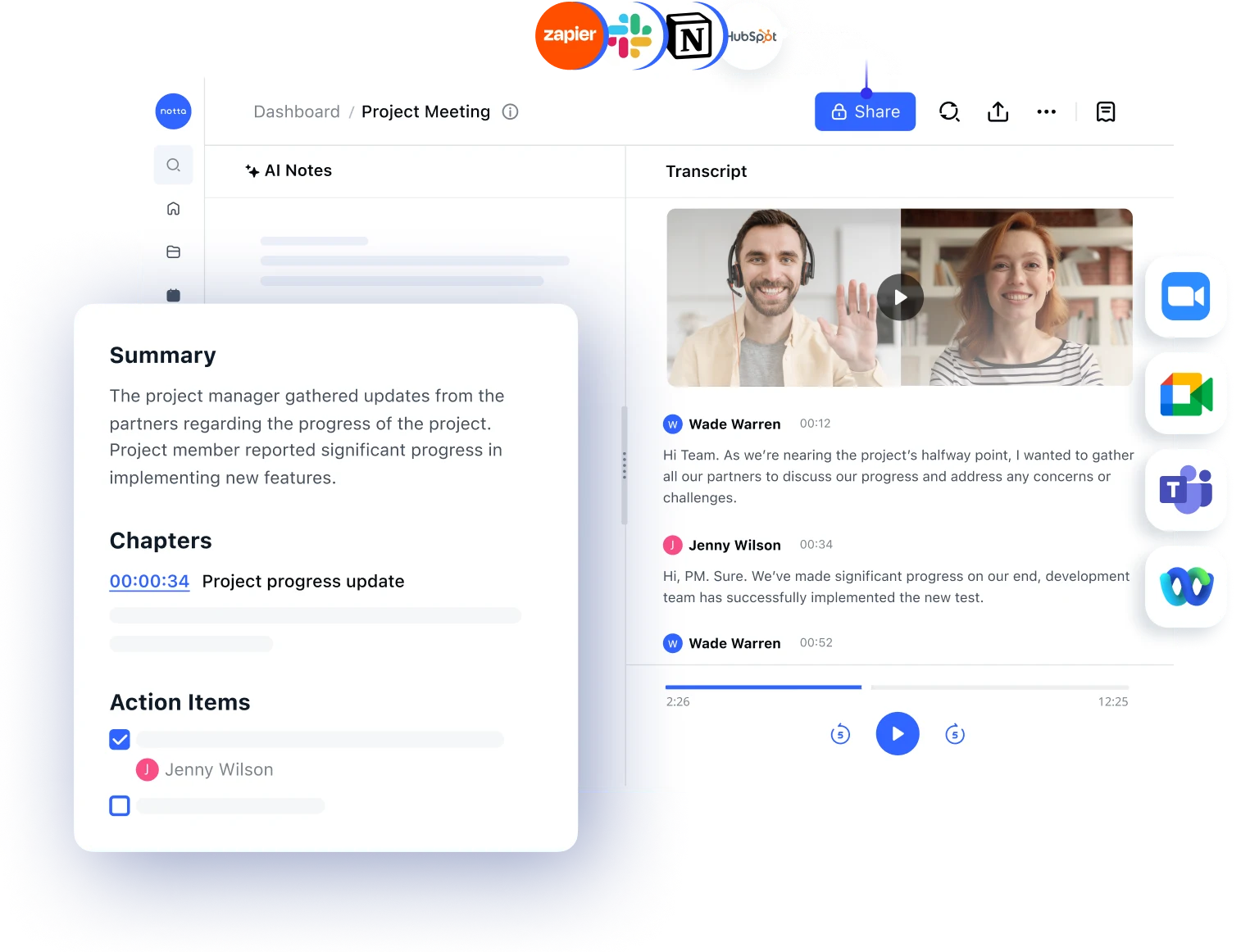
What is an Offsite Meeting and How to Organize One?
Unlock the power of AI — Notta's meeting assistant records, transcribes and summarizes meeting minutes with one click.
It’s easy to get stuck in routines and old ways of thinking, which translates into stagnation and falling behind competitors. As a manager, you should take on the habit of thinking: what do we need to change for change to happen?
The answer can be as easy as switching locations and letting the outer change inspire inner change – one of the goals of an offsite meeting!
An offsite meeting can help boost creativity and entice your employees to think outside the box. A successful offsite meeting gives a great output in terms of productivity and employee satisfaction, but it requires thorough planning.
Fret not – in this article, we’ll provide the ingredients for the perfect offsite meeting!
What is an offsite meeting
An offsite meeting is a meeting held in a location outside of the office. Maybe you’ve noticed how even a tiny change, such as taking a different way to your favorite coffee shop, inspires new thought patterns.
Similarly, an offsite meeting takes everyone out of their comfort zone. The meeting’s focus may be team building, strategic planning, continuous education for managers-to-be, or a summit. It’s often held in a non-corporate environment, for example, a castle, and preferably in a relaxing, beautiful setting.
An offsite meeting typically mixes work-related activities, such as sit-down lectures/conferences, with team building and connection. It comes with breaks where you can socialize or take a walk in the surrounding nature.
For the duration, it is recommended to allocate at least half a day – with the possibility of a full day or staying overnight – since there’s traveling involved.
Why are offsite meetings important
First and foremost, offsite meetings shake things up like a smoothie blender. This lets your team break old patterns and see things from a fresh perspective.
Creativity and motivation boost
Often, the change of scenery leads to increased productivity and motivation among your employees – motivation that hopefully stays when you’re back at your office. It provides a welcome break from the familiar corporate environment or home office, allowing employees to relax and recharge their batteries.
Increased innovation
Having your team members come together in an unusual setting can also boost innovation. Maybe the usually quiet person with great ideas finds the courage to speak up outside of the more formal office meetings. Also, offsite meetings usually involve time for socializing and team-building activities aimed at inspiring collaboration and idea-sharing.
Bonding with your boss
And your colleagues – a successful offsite meeting doesn’t only bear measurable fruit in the form of innovation, ideas, and strategic plans but also in more cohesive teams and happier employees. And as the saying goes – happy employees, happy managers!
More compassion for colleagues
Putting yourself in someone else’s shoes makes it easier to feel compassion. You’ll likely avoid being annoyed when someone takes time to reply to messages if you know how much pressure they face daily. An offsite meeting provides the opportunity to dive deep into the roles of each team member. This is something you often don’t have time for at the office!
Getting to know how each person works and what makes them tick also provides valuable information leading to better teamwork back at the office.
Move towards a common goal
If your offsite meeting is strategic in nature, an essential factor is to ensure everyone gets the bigger picture. When only managers and seniors understand where you’re heading, the team can have difficulties staying motivated since they don’t see the value in the daily tasks. Making everyone feel valued and recognized is the recipe for a successful offsite meeting!
Untangle misunderstandings
When everyone is on board with where you’re heading, you reduce the risk of misunderstandings due to lack of context. When people get why they’re assigned certain work assignments, it’s also easier for them to take initiative and not rely too much on their manager.
Ensuring everyone is on the same page and ready to put in their best efforts should thus be a crucial part of your offsite meeting.
Notta offers the most integrated AI meeting notes, summaries, and action items so nothing gets missed.
How to plan and host a successful offsite meeting
Follow our offsite meeting checklist to secure all the steps to running an unforgettable get-together!
1. Have a clear purpose
First things first – why are you planning an offsite meeting?
No one likes those endless meetings that keep missing the point like a drunk dart player. Offsite meetings are no exception – throwing one just to show your employees that you care is not reason enough.
Are you hosting an offsite meeting to encourage team cohesion after a reorganization? To train your next-generation managers in leadership skills? Or to share the new strategic plan in an engaging and interactive way? By identifying the goals of the meeting, you can structure the agenda and activities accordingly.
2. Careful planning
A successful offsite meeting starts way ahead of the date you’ve reserved.
The planning consists of the following:
Estimating your budget. What finances does your company have at hand for offsite meetings? Get clear on this to avoid the deception of finding the perfect place. only to not be able to afford it.
Deciding on the date. Make sure it doesn’t clash with important business events, stakeholder meetings, or public holidays.
Finding the perfect venue. A zen setting in nature gives everyone a breather and beautiful memories (and Instagram stories!).
Fixing food. Does the venue offer food, or do you need to sort out catering? Are there any special dietary needs?
Taking care of transportation. Is everyone responsible for getting to the venue by themselves and getting reimbursed later? Or are you booking a shuttle from the office – or going all together by car/public transport?
Deciding the content and preparation. Do you want the participants to read up on something in advance for a more streamlined meeting?
3. Remind in advance
People have a lot on their plates, and it can be easy to forget the details. Remind your team about the time, place, and other relevant information in person (if you’re working at an office), during meetings, company newsletters, and on social platforms like Slack or Workplace.
Do they need to bring something in particular (for example, a bathing suit), or prepare something, like watching a training video or reading through a pdf? Make sure that you remind your team about these essentials over and over.
4. Pick a coordinator
Delegate tasks like sending out reminders, answering questions, and organizing the logistics on the meeting day to a coordinator. This helps you stay focused on the meeting and being present with the participants.
You will want to take notes to keep track of all the insights and brilliant ideas. However, remember that information doesn’t lead to change – implementation does. Have an action plan for how you will turn ideas into action to maximize the benefits of the offsite meeting.

5. Prepare team building activities
Even if the offsite meeting isn’t purely about team building, there should be some aspect of connecting with your coworkers.
It can be tempting to organize a soccer game if you and a group of your colleagues are into sports. Or a yoga class if you enjoy spending your early mornings in downward-facing dogs.
However, not everyone appreciates physically demanding activities – and let’s admit it, standing in a forward fold in front of your boss could be slightly awkward. Have every colleague in mind when you plan the activities, and you’re good to go.
6. Make space for everyone
All group settings have those people who just can’t stop talking. This is not necessarily a bad thing; however, it is your job as a facilitator to ensure everyone is seen and heard, not just those who speak the loudest. You can, for example, ask for everyone’s opinion and pass on the question from person to person until everyone has given their point of view.
7. Evaluate and follow up
After the offsite meeting concludes, take the time to evaluate its success. Gather feedback from participants through surveys or group discussions to identify areas of improvement for future meetings. Additionally, follow up on action items and decisions made during the meeting to ensure that progress is being made. This will help maintain momentum and accountability among team members.
4 offsite meeting ideas that are worth trying
As the saying goes: the sky is not the limit – the mind is. Your imagination is the only limit to what you’ll cover during an offsite meeting.
That said, here are our top four offsite meeting ideas:
Brainstorming
Follow some brainstorming structure to milk out the best of everyone’s creative genius. Make sure to take action on the brightest ideas when back at the office.
Elevator pitch
This is a fun and challenging exercise where employees get to motivate what they do and why it matters in a short pitch. It helps everyone stay motivated and proud of their work, and see how it contributes to your common goals!
Cooking class
For the socializing/team-building part of an offsite meeting, a cooking class can be a delicious way to connect and instantly benefit from your co-creations!
Scavenger hunt
You never get too old for a good ole’ scavenger hunt! Incorporate a meeting discussion topic at each point for the perfect mix of work and play. Make sure it’s not too long and physically demanding. Remind the participants to bring comfortable walking shoes before the offsite meeting.
At the end of the day, it all comes down to knowing your employees and sensing what works best for them.
To conclude
The defining characteristic of an offsite meeting is that it takes place outside of the office. Ideally, you’ll want a beautiful location in nature.
That being said, it all comes down to budget and convenience. The most important feature of a successful offsite meeting is the human side – that everyone feels seen and appreciated. Tailor the team-building activities to everyone’s liking rather than a few, find the perfect balance of challenge and fun, and you’re set for a successful offsite meeting that your team refers back to for years to come!